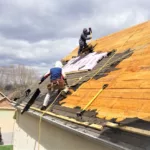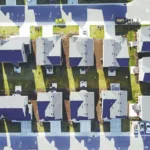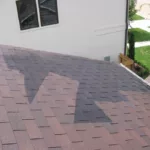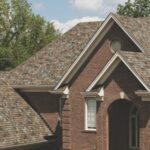Hailstorms can cause serious damage to a roof. The impact from a hailstone can bruise or crack roofing shingles, potentially leading to water damage in your home. While you can’t always avoid roof damage from hail, you can help to minimize the extent of damage by detecting problems early, taking action to repair or replace your damaged roof as quickly as possible, and installing Class 4, impact-resistant roofing shingles.
Find out what you can do to help protect your roof and home from the potential consequences of hail damage.
How Do I Know If My Roof Has Been Damaged by Hail?
In the aftermath of a hailstorm, it’s important to get your roof checked for damage. Hail falls in random patterns and therefore may only damage a few houses within a neighborhood, so your roof may have damage even if your next-door neighbor’s roof doesn’t.
Look for signs of hail damage around your yard and property, such as:
- Plants stripped of their leaves
- Dents in cars
- Damaged air conditioner units, or
- Evidence of damage to other exterior furnishings
Get a Roof Inspection for Hail Damage
It may be difficult to spot some types of roof damage from the ground, so you’ll want to get as close to the surface of the roof as possible for a complete inspection. We recommend scheduling an inspection with a professional roofing contractor that you trust to safely and thoroughly inspect your roof. Most roofing contractors provide free inspections and estimates. If you do decide to inspect the roof yourself, please follow all appropriate safety guidelines.
Surface Hail Damage
The first type of damage you want to look for is damage to the surface of your roof. If you have an asphalt shingle roof, you may notice the following signs of damage after a hailstorm:
- Small divots
- Round black areas
- Bruises, and/or
- Loss of protective granules, which may collect in gutters and downspouts
Hidden and Related Roof Hail Damage
Not all hail damage can be seen on the surface of a roofing shingle. Sometimes the impact from a hailstone can cause shingles to split and can only be seen when you look at the backside of the roof shingles. It’s best to call a roofing contractor to assist in this type of inspection, as they can lift-up, examine and re-seal shingles as needed. A professional roofing contractor will also assess other roofing components for damage, such as flashing, roof vents, skylights, gutters, and chimney caps or covers.
Imitation Hail Damage on a Roof
It’s important to correctly identify the type of roof damage so the best action plan can be put into place, which may involve warranty and insurance claims. An experienced roofing professional should be able to differentiate hail damage from other types of roof damage, such as
- Blistering and cracking caused by UV degradation from the sun,
- Scuffing damage from when shingles were installed
- Wind and debris defacement, and
- Worn-out shingles
Once the damage is identified, your roofing contractor can provide an estimate and advise on the next steps to getting your roof repaired or replaced.
Is It Necessary to Fix Roof Hail Damage?
If your roof has been damaged by hail, it can be difficult to understand whether the damage is only cosmetic or if it could also impact roof performance. If hail damage is allowing water to pass through your roofing system, then this is a performance issue and should be fixed as soon as possible to help prevent serious water damage to your home.
If hail damage has caused granule loss on your roof shingles, it could also affect the performance of the shingle, in addition to the aesthetics. Granules on asphalt shingles help to protect the asphalt from UV light degradation caused by the sun. While you may not have a roof leak right away, shingles that have lost granules have a higher risk of failing prematurely.
Is Roof Hail Damage Covered by Insurance?
Most insurance policies will cover hail damage, but it’s best to study your homeowner’s policy in-depth, especially if you live in a region prone to hailstorms. Some of the common stipulations associated with hail related insurance claims include:
- Homeowners usually have within one year to file a claim.
- Most policies require a deductible payment before the insurance company pays its share.
- Filing a claim may cause your premium rates to rise.
- Some states (those with a higher frequency of hail claims) may have percent-based deductibles.
- Cosmetic roof hail damage may not be covered.
Contact your insurance agent to learn more.
Tips on Handling Hail Damage Claims
- Always get references, read reviews and compare estimates before choosing a contractor. It’s also best to take the time to verify certificates of insurance and licensing if required in your area.
- Notify your insurance company immediately to open a claim. Some companies have mobile apps and online tools to ease the filing process, but you can always call in, as well.
- If your contractor agrees to work with your insurance company, make sure you understand in detail what each will do and what steps are required by you.
Can You Prevent Roof Hail Damage?
If you live in an area that is prone to hailstorms, or hail is forecasted in your area, then anything on the exterior of your home and property left outdoors may be at risk for hail damage, such as vehicles, patio furniture, and landscaping.
Since you can’t “pull your roof into the garage” when there’s a storm, you may want to install roofing materials that are designed to withstand greater levels of impact, such as Class 4, impact-resistant shingles, which may help to prevent or reduce the amount of damage from hail or other debris.
Additionally, installing Class 4 shingles on your home may qualify you for a homeowners’ insurance discount. Contact your insurance agent to learn more.
While you may not be able to prevent all hail related roof damage, you can help to minimize the amount of damage and the consequences of that damage in your home. In addition to installing Class 4, impact-resistant roofing shingles, early detection and action are key.














